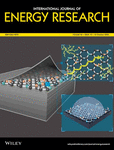Thermal-hydraulic analysis of wire-wrapped rod bundle in lead-based fast reactor with non-uniform heat flux
Funding information: Guangdong Provincial Key R&D Program, Grant/Award Number: 2021B0101250002; Natural Science Foundation of Guangdong Province, China, Grant/Award Number: 2020a15110753
Summary
As one of the most promising advanced reactors, the lead-based fast reactor has drawn great attention due to economic and safety advantages. Investigating thermal hydraulics is essential for the design of a lead-based reactor. In this paper, a CFD simulation of a 19-wire-wrapped-rod bundle with lead-bismuth eutectic (LBE) as coolant is carried out using the Reynolds-averaged Navier-Stokes equation method, and four different types of axial non-uniform heat flux are applied. Excellent validation of results for thermal and hydraulic aspects is obtained first by comparing simulation results using turbulent model k-ω SST with experimental data and high-fidelity large eddy simulation data. The mechanism of transverse flow variation in subchannels and faces resulting from changing locations of wires is studied. The strong transverse flow at the edge and corner subchannels lead to a more distinct oscillation in peripheral cladding temperature under non-uniform heat flux. The hot spot issue for blockage conditions is studied, and it is found that the temperature increment at blockage is linear to the local heat flux. When the blockages locate at the peak normalized heat flux of 1.56, there is no evident difference in the maximum temperature when changing the heat flux pattern, with an averaged Tmax of 732 K. Even though the normalized heat flux is high at 1.89, the flatter and lower temperature distribution would not lead to a remarkable high hot spot temperature compared with that of 1.56. The distribution of hot spots, as well as the inhomogeneity of heat transfer in different heat flux patterns, provide a reference for lead-based reactor design.




